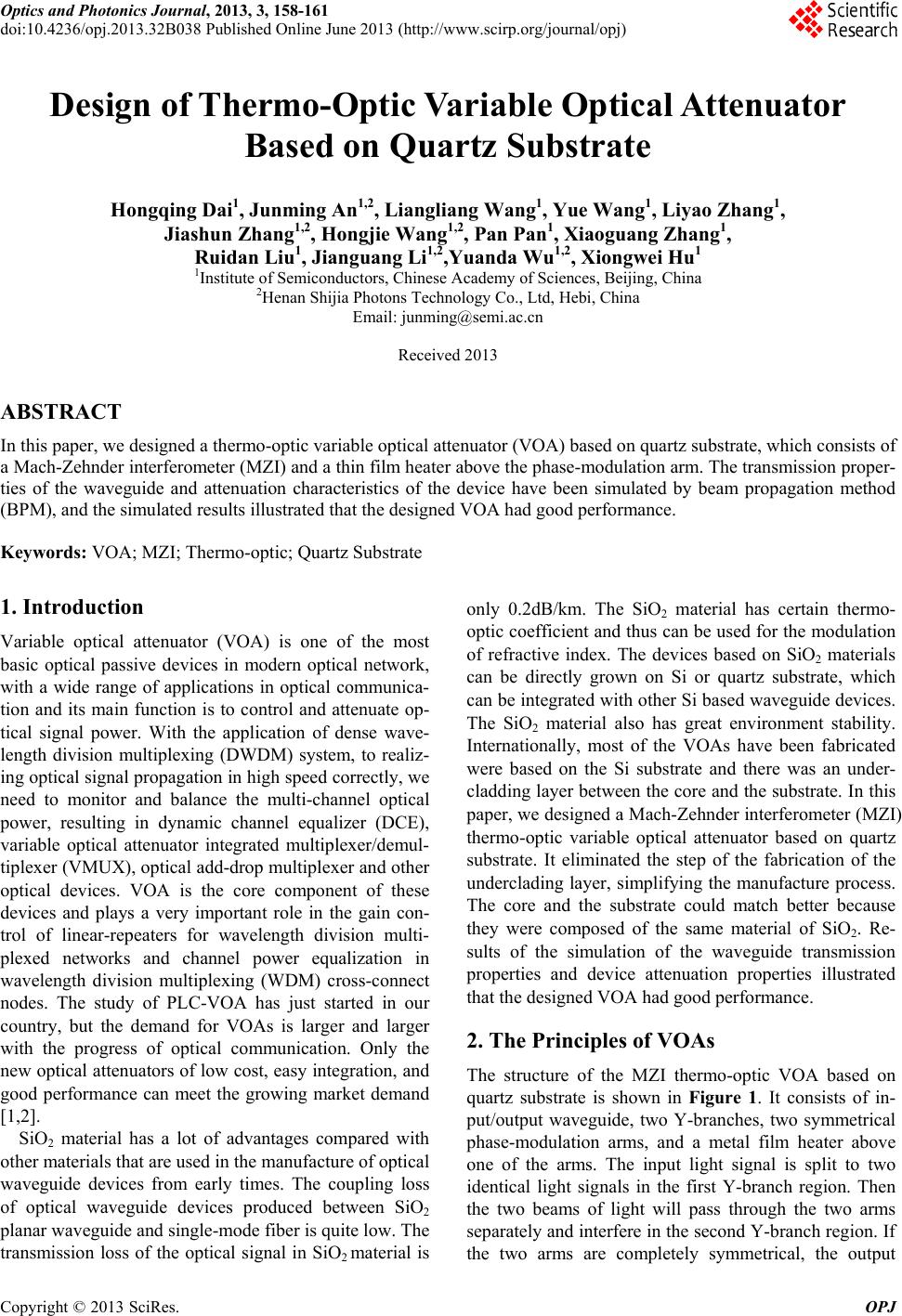
Optics and Photonics Journal, 2013, 3, 158-161
doi:10.4236/opj.2013.32B038 Published Online June 2013 (http://www.scirp.org/journal/opj)
Design of Thermo-Optic Variable Optical Attenu ator
Based on Quartz Substrate
Hongqing Dai1, Junming An1,2, Liangliang Wang1, Yue Wang1, Liyao Zhang1,
Jiashun Zhang1,2, Hongjie Wang1,2, Pan Pan1, Xiaogu ang Z hang1,
Ruidan Liu1, Jianguang Li1,2,Yuanda Wu1,2, Xiongwei Hu1
1Institute of Semiconductors, Chinese Academy of Sciences, Beijing, China
2Henan Shijia Photons Technology Co., Ltd, Hebi, China
Email: junming@semi.ac.cn
Received 2013
ABSTRACT
In this paper, we designed a thermo-optic variable optical attenuator (VOA) based on quartz substrate, which consists of
a Mach-Zehnder interferometer (MZI) and a thin film heater above the phase-modulation arm. The transmission proper-
ties of the waveguide and attenuation characteristics of the device have been simulated by beam propagation method
(BPM), and the simulated results illustrated that the designed VOA had good performance.
Keywords: VOA; MZI; Thermo-optic; Quartz Substrate
1. Introduction
Variable optical attenuator (VOA) is one of the most
basic optical passive devices in modern optical network,
with a wide range of applications in optical communica-
tion and its main function is to control and attenuate op-
tical signal power. With the application of dense wave-
length division multiplexing (DWDM) system, to realiz-
ing optical signal propagation in high speed correctly, we
need to monitor and balance the multi-channel optical
power, resulting in dynamic channel equalizer (DCE),
variable optical attenuator integrated multiplexer/demul-
tiplexer (VMUX), optical add-drop multiplexer and other
optical devices. VOA is the core component of these
devices and plays a very important role in the gain con-
trol of linear-repeaters for wavelength division multi-
plexed networks and channel power equalization in
wavelength division multiplexing (WDM) cross-connect
nodes. The study of PLC-VOA has just started in our
country, but the demand for VOAs is larger and larger
with the progress of optical communication. Only the
new optical attenuators of low cost, easy integration, and
good performance can meet the growing market demand
[1,2].
SiO2 material has a lot of advantages compared with
other materials that are used in the manufacture of optical
waveguide devices from early times. The coupling loss
of optical waveguide devices produced between SiO2
planar waveguide and single-mode fiber is quite low. The
transmission loss of the optical signal in SiO2 material is
only 0.2dB/km. The SiO2 material has certain thermo-
optic coefficient and thus can be used for the modulation
of refractive index. The devices based on SiO2 materials
can be directly grown on Si or quartz substrate, which
can be integrated with other Si based waveguide devices.
The SiO2 material also has great environment stability.
Internationally, most of the VOAs have been fabricated
were based on the Si substrate and there was an under-
cladding layer between the core and the substrate. In this
paper, we designed a Mach-Zehnder interferometer (MZI)
thermo-optic variable optical attenuator based on quartz
substrate. It eliminated the step of the fabrication of the
underclading layer, simplifying the manufacture process.
The core and the substrate could match better because
they were composed of the same material of SiO2. Re-
sults of the simulation of the waveguide transmission
properties and device attenuation properties illustrated
that the designed VOA had good performance.
2. The Principles of VOAs
The structure of the MZI thermo-optic VOA based on
quartz substrate is shown in Figure 1. It consists of in-
put/output waveguide, two Y-branches, two symmetrical
phase-modulation arms, and a metal film heater above
one of the arms. The input light signal is split to two
identical light signals in the first Y-branch region. Then
the two beams of light will pass through the two arms
separately and interfere in the second Y-branch region. If
the two arms are completely symmetrical, the output
Copyright © 2013 SciRes. OPJ